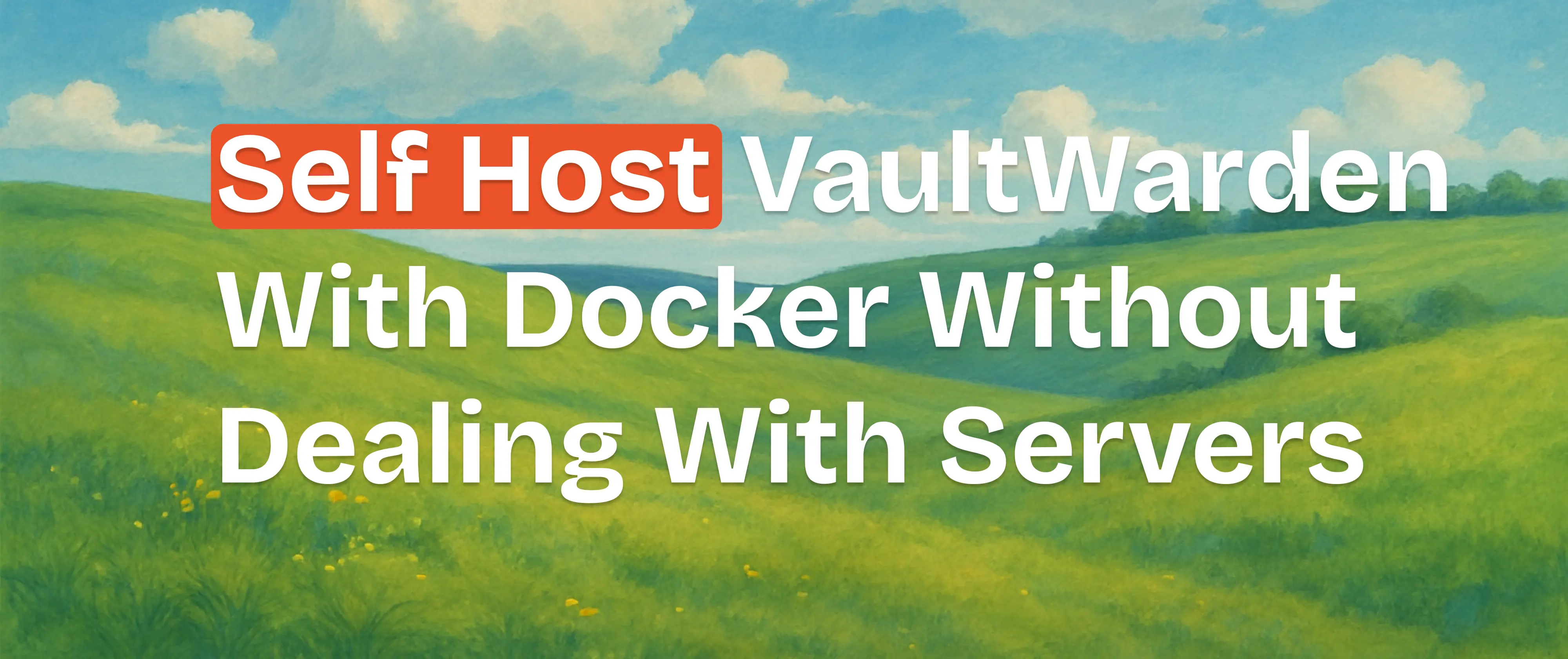
How I Self Host VaultWarden With Docker Without Dealing With Servers
 Jonas Scholz
Jonas ScholzI like hosting my own stuff. I don’t like dealing with server maintenance.
If you’ve looked into running your own password manager, you’ve probably come across VaultWarden, the unofficial lightweight Bitwarden server written in Rust. It’s open source, works with the official Bitwarden clients, and runs fine on a tiny VPS.
But running it yourself comes with overhead: you have to set up Docker, reverse proxy configs, HTTPS, firewall rules, updates, backups… and that’s just for one service.
I wanted something in between:
- Not a US based SaaS that holds my credentials
- Not a totally unmanaged VPS where I’m responsible for everything
- Something simple, secure, and hosted somewhere I actually trust
So I deployed VaultWarden on Sliplane, my own managed Docker hosting platform. It’s kind of like self hosting, but without the operational chores.
Let’s break it down.
Why Self Host VaultWarden
Password managers hold literally everything — logins, 2FA secrets, private notes. Trusting that to a third party service (especially one hosted in the US) comes with some risk.
VaultWarden is:
- Private: You decide where it runs and who can access it
- Lightweight: It runs great on small machines
- Compatible: It works with the official Bitwarden apps
- Open source: You can inspect and verify exactly what it does
Self hosting VaultWarden gives you full control. But...
Why Full Self Hosting Can Suck
Here’s the stuff you have to handle when self hosting on a VPS:
- Keep the OS updated
- Patch Docker and system dependencies
- Reverse proxy and HTTPS certs
- Firewall setup
- Logs, backups, monitoring
- Hope you’re not the next person burned by a missed CVE
And if something breaks at 3 AM, guess whose inbox gets the downtime alert?
Honestly, if you’re only running one or two apps, it can feel like overkill.
If you want to self-host anyway, here is a simple Docker Compose file you can use:
services:
vaultwarden:
image: vaultwarden/server:latest
container_name: vaultwarden
restart: unless-stopped
environment:
- DOMAIN=https://vault.yourdomain.com
- WEBSOCKET_ENABLED=true
volumes:
- vaultwarden-data:/data
networks:
- internal
caddy:
image: caddy:alpine
container_name: caddy
restart: unless-stopped
ports:
- "80:80"
- "443:443"
volumes:
- caddy-data:/data
- caddy-config:/config
- ./Caddyfile:/etc/caddy/Caddyfile
networks:
- internal
volumes:
vaultwarden-data:
caddy-data:
caddy-config:
networks:
internal:
driver: bridge
and you need a Caddyfile:
vault.yourdomain.com {
reverse_proxy vaultwarden:80
}
Caddy handles TLS automatically via Let’s Encrypt. Just replace vault.yourdomain.com with your actual domain, and you’re good to go.
This setup gives you full control — but it also means you’re on the hook for updates, backups, and securing the server itself.
What I Actually Use: Sliplane
I built Sliplane because I wanted Docker based hosting that was:
- Easy to use
- Not tied to US infrastructure
- Still gave me the flexibility of running my own services
With Sliplane, you can deploy VaultWarden (or anything else) to a managed Linux server in a few minutes:
- Servers are hosted in Germany
- Backups, firewall rules, and OS security updates are handled
- It's still your Dockerfile and your data
- It doesn't cost more than 9 Euros per month :)
Basically: I get most of the benefits of self hosting, without spending hours on setup or maintenance.
The Trade Off
This isn’t total control and I think it’s worth calling that out.
When you use Sliplane, you’re trusting us to:
- Manage the base infrastructure
- Keep the servers secure and online
- Handle updates and backups correctly
You’re not running your own physical hardware. You don’t manage the hypervisor. And if we go down (we haven’t), so do your services.
So if you’re hardcore about owning everything, bare metal or self managed VPS might still be your best option.
But if you just want to run open source apps, stay in the EU, and avoid AWS style lock in, it’s a solid middle ground.
How to Deploy VaultWarden on Sliplane
Here’s the fun part, I’ll walk you through how to get VaultWarden running on Sliplane with automatic HTTPS, backups, and updates:
Let me know if you’re curious how this compares with other setups, or want to see examples for different self hosted apps.
FAQ
What’s the difference between VaultWarden and Bitwarden?
VaultWarden is an unofficial, lightweight server implementation of Bitwarden written in Rust. It’s designed to be resource-efficient and easy to self host. The Bitwarden clients (web, mobile, desktop) work with both.
The official Bitwarden server is written in .NET, uses more resources, and comes with some additional enterprise features. VaultWarden focuses on simplicity, speed, and self hosting without the overhead.
Is VaultWarden secure?
VaultWarden uses the same end to end encryption model as Bitwarden — all encryption and decryption happens on the client side. That means even if someone got access to your VaultWarden server, they still wouldn’t be able to read your data without your master password.
That said, you’re still responsible for securing the server it runs on. That includes things like HTTPS, strong admin passwords, and regular updates — unless you're using something like Sliplane, which handles a lot of that for you.
Where is Sliplane based?
Sliplane is a German company. All infrastructure is located in the EU, including the data centers we use. No US cloud providers involved.
If data sovereignty and local hosting matter to you, especially in the context of GDPR or avoiding US-based platforms, Sliplane gives you a trustworthy alternative without needing to manage everything yourself.
Cheers,
Jonas, Co-Founder of Sliplane